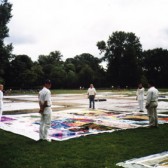A quilt consists of eight name flags sewn together, each made in memory of someone on the impact of AIDS is deceased. Some name flags are simple and clear, others look busy and seem imbued with personal memories of the deceased. Each name flag is a precious thing. You look at it that the people who stayed behind the flag name with great care and love have put together. Sometimes there is a picture on the canvas and usually there is a name to read. But there are also quilts with no names, like the quilt from Chile. The taboo against AIDS is so great that it is dangerous even for the survivors to put the name of the deceased on the quilt.
The opening day was a cloudy Saturday with constantly threatening rain. The puddles have been vacuumed up as best could be done. After the opening speeches Erik Windhorst plays ‘The Rose’ on his bagpipes. In the background a young athlete tunes her stretching exercises to the mournful music.
There is also a quilt where every passerby can write the name of a loved one who is deceased, and not just people with AIDS. This is the Gay Games V quilt. During each Gay Games such a quilt is created, and it never emains empty.
A ritual that often takes place in quilt exhibitions is the reading of names of the deceased. People of various nationalities were on stage throughout the day to read the names.
Toi is from Thailand. On Sunday he is one of the people reading names. The context is poignant and painful, but as Toi gets ready, he keeps smiling, and walks to the stage where the two Thai quilts can be seen. They are very colorful, almost every name flags have a picture of something or other. A frog. A cat. Fish. A bridge. “That flag is the name of someone who lived on the river. When they started building a large modern bridge, he had to move. He did not, but was forced to leave. We sewed the bridge on his quilt.”
The Chewit Names Project in Nonthaburi, where Toi works, focuses on supporting and enhancing the resilience of people with HIV. There is a telephone helpline, where many ideas and experiences are exchanged. It is also possible to give information to students and prostitutes. Toi: “We have no money for proper medication to do more. Nor do the patients or the government. And there is no insurance. A few people get medication from the hospital. So we focus on other aspects of health care. We do a lot with herbs, massage and meditation. People feel better with. all we can do.”
Toi is a painter, but he can not earn a living. He talks about the Chewitt Project, where art is used as a means to understand AIDS. From this project came the two quilts displayed at Vondelpark. “Making art means that you have a thought process in a very personal way of shaping. We work with students so they can design and make their own educational materials. They use them again for information on their schools and their communities. It is a positive way of working I think: you give your feelings shape, you can express commitment to people with HIV, or show that you sympathize with those who someone with HIV in the family.”
Sunday and Monday were two sunny days when many people viewed the quilts. The names will be read again, endless rows of names. In between music sounds. “Are there really so many people who’ve died, mama?” A child’s voice sounds clear across the grounds. The child’s mother tries to explain to her daughter. The adults, no less impressed, look at all those names and are quiet. A few hundred meters away football players practice for their Gay Games competition. Birds sing, the sun shines. “You must live,” said Toi. And he smiles.







No comments:
Post a Comment